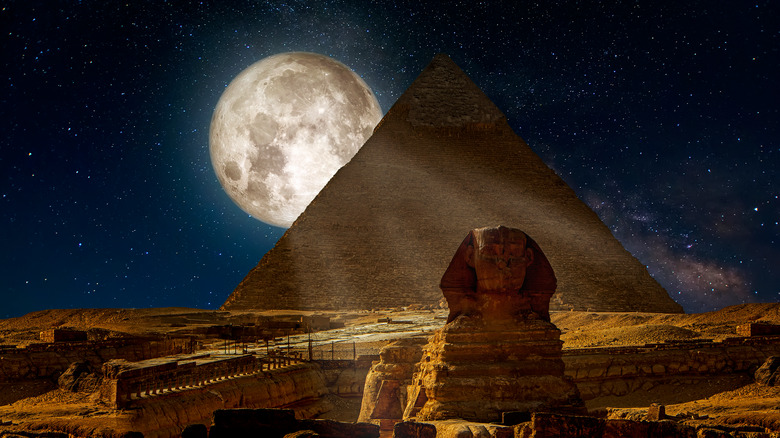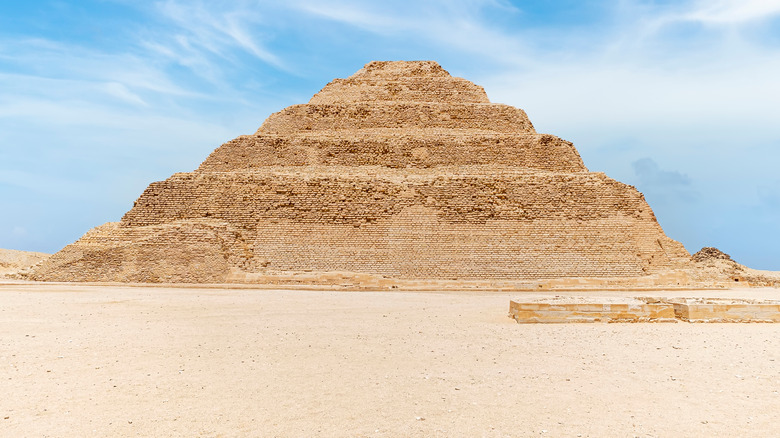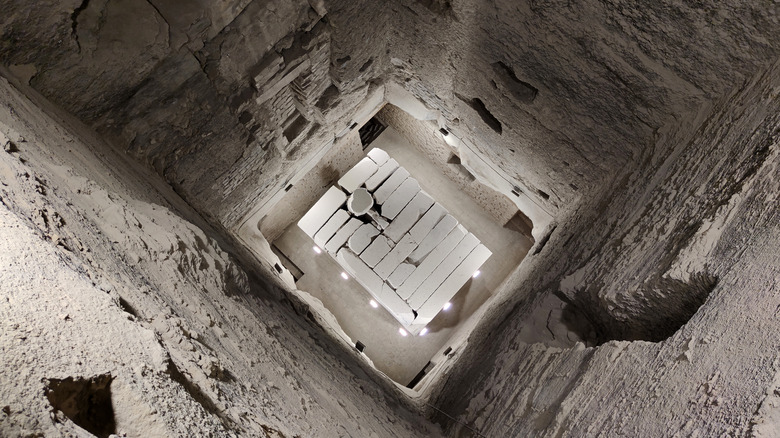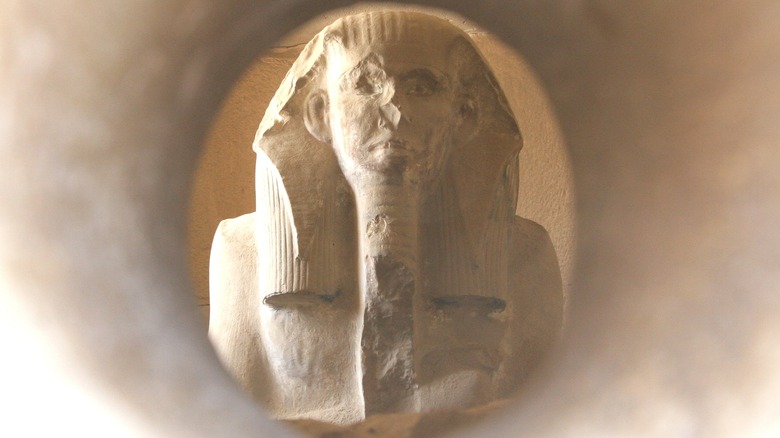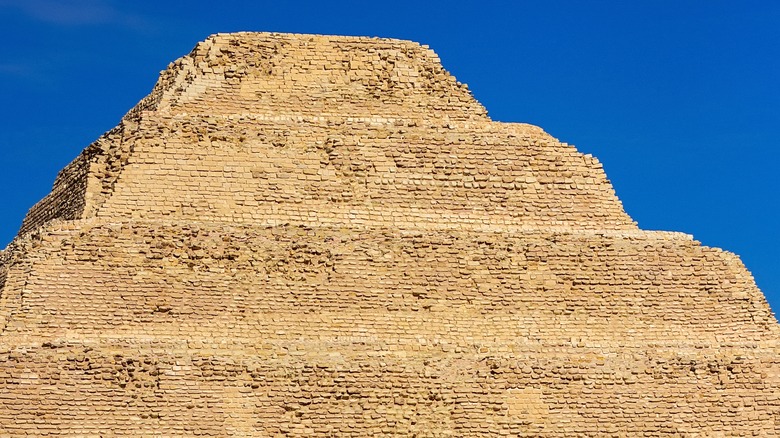Egypt's Oldest Pyramid Is Not The Pyramid Of Giza
What is the oldest pyramid in Egypt? Surprisingly, it's not the Great Pyramid of Giza, even though the image of that ancient wonder frequently dominates the imaginations of many. According to National Geographic, that pyramid was built around 2550 B.C., some 4,500 years ago, during the reign of the Egyptian pharaoh known as King Khufu. But believe it or not, there's another pyramid that's even older — and it helped ancient Egyptian architects develop the techniques that made the Giza pyramids possible, according to Discover Magazine.
So no, the oldest pyramid in Egypt isn't one of the three found in Giza right next to the Great Sphinx, but the Pyramid of Djoser. Located 10 miles south of the Giza giants, the Pyramid of Djoser was built circa 2630 B.C. In addition to being the oldest Egyptian pyramid, it's also the oldest stone pyramid anywhere in the world, as well as the first stone building constructed on a large scale (via Insider). Like the wonders at Giza, the Pyramid of Djoser is a tomb, built for the pharaoh of the same name. (Well, sort of — though commonly known as Djoser or Zoser, the ancient Egyptian king was actually referred to as Netjerykhet by his contemporaries, per Live Science.) And as Discover noted in their coverage, his 19-year reign as the second ruler during Egypt's third dynasty essentially paved the way for the architectural magnificence of what was meant to be his final resting place.
The oldest pyramid was designed by an important Egyptian figure
The Pyramid of Djoser might have been named for a king, but it was designed by a man who, in some ways, became a bona fide God. As Discover noted in their 2020 write-up of Egypt's oldest pyramid, Djoser's chief minister, a man named Imhotep, is the polymath credited with coming up with what would become an architectural feat. (In addition to designing the world's first stone pyramid for his ruler, Imhotep wore many hats: as an astronomer, mathematician, poet, priest, and physician who argued that diseases were due to natural causes rather than divine intervention.) Due to his many accomplishments — among them, the Pyramid of Djoser — Imhotep was later made into later deified as the Egyptian god of wisdom and medicine (via Britannica).
According to a 2012 summary of the pyramid's construction published by Live Science, Imhotep used an already-existing form of Egyptian architecture to, quite literally, build upon it. Using a preexisting structure known as a mastaba — a kind of stone tomb with a flat roof and slanted slides — Imhotep built Djoser's pyramid in stages. Riffing on the mastaba design, the architect used a large mastaba as a base, and level by level stuck several smaller mastabas on top of each other. In its final form, made of approximately 11.6 million cubic feet of stone, the Pyramid of Djoser stood at 197 feet with six mastaba layers.
What lies beneath the Pyramid of Djoser?
Is there more to the Pyramid of Djoser than meets the eye? According to Live Science, yes. Beneath the structure is a maze of tunnels that run, in total, approximately 3.5 miles long. At the center of the maze is a 90-foot shaft, with Djoser's burial chamber located at the bottom of it. As Live Science noted, Djoser's remains kept company those of at least 11 of his daughters. (Per a 2020 article published by the U.K. Express, the whereabouts of Djoser are unknown, and remain so as of this writing.) In addition to the burial chamber, three magazine galleries are located beneath the pyramid, as well as a tunnel filled with food offerings, a tunnel filled with 40,000 stone vessels (many of which stored the remains of the king's ancestors), and a palace meant for Djoser to use in the afterlife.
According to Atlas Obscura, researchers largely believe the labyrinthine tunnels located below the Pyramid of Djoser were designed to prevent looting thieves. Unfortunately, the preventative measure seemingly created its own set of problems thousands of years later. For a time, experts were concerned the tunnels would collapse and cause the pyramid to cave. The monument was also badly damaged in a 5.8 magnitude earthquake in 1992 (via ABC News). In order to save the pyramid from crumbling, Egyptian officials closed it to the public from 2006 until 2020, per Insider, and cost roughly $6.6 million to complete.
Djoser's pyramid has a complex situation -- but it's not what you think
The Pyramid of Djoser is not alone in the desert. It's actually part of a larger complex — one which covers 37 acres, according to Live Science. Surrounded by a 30-foot wall featuring one real door and 13 false ones, the pyramid complex hosts a number of facade dummy buildings. Per Atlas Obscura, the reason they were built and specifically placed was ritual in purpose. Following the construction of the complex, its builders purportedly then partially buried the structure, according to Egyptologist Mark Lehner, though the reasoning behind it remains unknown (via the Encyclopedia).
Among the complex's notable features is a statue of Djoser himself, surrounded by a stone structure called a "serdab," per Live Science. Essentially an ancient stone version of a stereoscope, the statue is concealed behind a wall and is only visible by way of a very small tapered tunnel. In addition to the likeness of Djoser, the complex also contains a mystery — namely, about one of its buildings. Called the "Southern Tomb" due to its location within the burial compound, the building touts its own set of tunnels beneath its foundation, much in the style of the king's tomb, according to ABC News. It is unknown as of this writing who or what was buried there.
Imhotep designed an actual stairway to heaven
Per a 2021 piece published by The Collector, the Pyramid of Djoser's step-like design was imbued with a symbolic significance — the stacked mastabas were meant to represent Djoser's literal ascent to godhood after death. Beyond symbolism, it served as the architectural foundation for later monuments, including — you guessed it — the larger, smooth-sized Great Pyramids of Giza (via Live Science).
While Djoser's pyramid was meant to serve as Djoser's resting place, it's since acquired an (after)life of its own. As The Collecter highlighted in their explainer, the pyramid has cropped up everywhere in pop culture, from ancient times to the modern-day. Per The Collecter, the site was mentioned by ancient Roman historians and/or authors who wrote the modern-day equivalent of fan fiction featuring Imhotep. The pyramid also served as a popular tourist attraction for male European travelers following Napoleon's colonial takeover of Egypt in 1832 (via Britannica) and became the subject of a number of sketches and engravings throughout the 18th and 19th centuries. More recently, the Pyramid of Djoser and its complex made an appearance in the video game "Assassin's Creed: Origins," enabling players to explore the site all on their own — albeit a fictional one filled with cobras (via IGN).
